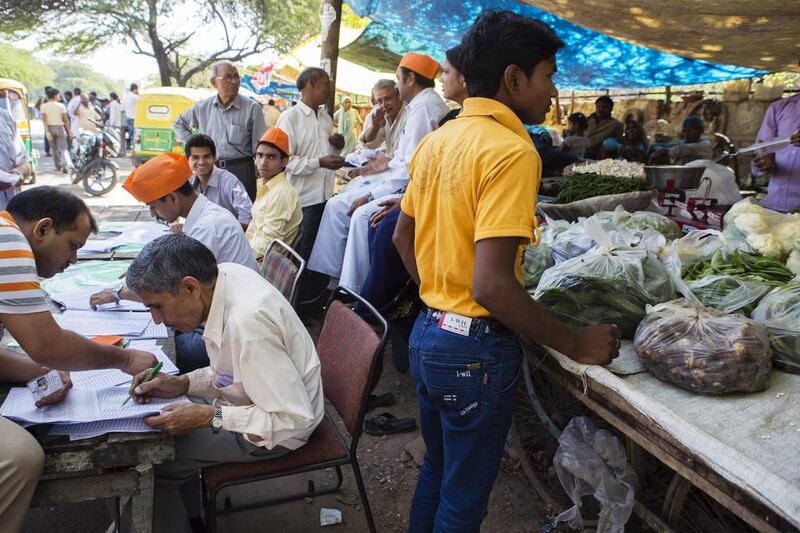NEW DELHI // In a crowded market lane in South Delhi’s Adhchini neighbourhood, Gopal Prasad cut a customer’s hair and talked politics in the Perfect Man Saloon.
It was Friday morning, a day after Delhi had voted in the third phase of India’s mammoth nine-phase election, a round of voting that had almost a fifth of parliament’s 543 seats up for grabs.
The men in the saloon gave passionate postmortems about who won Thursday’s vote even though official results won’t be announced until May 16.
“It’s time for the Congress to go, and I think that’s what will happen,” Mr Prasad said. He had voted, he said, for the Bharatiya Janata Party (BJP) candidate because he hoped that Narendra Modi, the BJP’s prime ministerial candidate, would come to power.
“Modi? How do you trust Modi?” another customer, waiting for a shave and reading a Hindi newspaper, scoffed. “How do you trust a man who abandoned his wife and never cared for her? How can such a man care for a country?”
He pointed to the front page of the newspaper, which had the news that Mr Modi had admitted to being married, although he had projected himself as a bachelor in the run-up to the election.
“I don’t worry about his marriage,” Mr Prasad said. “He says he can control prices, and that’s all I want.”
For many people of the poorer and lower middle classes, such as Mr Prasad, the biggest disappointment of the Congress-led government has been its failure to control inflation.
Mr Prasad has felt the pinch. He came to Delhi from the nearby Mathura, Uttar Pradesh, five years ago, to work in his uncle’s barbershop.
Apart from housing and feeding him, his uncle paid him a salary of 150 rupees (Dh9) a day.
Five years ago, Mr Prasad said, he used to be able to save at least 1,500 rupees a month. But each year since he found himself spending more as his salary remained about the same and the price of a haircut in the saloon increased from 40 rupees to 50.
“I’m lucky now if I can save even 500 rupees a month,” Mr Prasad said.
He admitted his large white smartphone and smart pink shirt and well-tailored brown trousers belied the possessions of a person struggling with money.
“All right, maybe I spent some money on myself, too. But the cost of even ordinary living has gone up. Ask anybody.”
Last month, the inflation rate for retail prices stood at 8.19 per cent. The rate for food products had dropped in February to 4.68 per cent, but as recently as September, it stood at 6.46 per cent, driving up the prices of onions four-fold to 100 rupees (Dh6) per kilogram.
“Food inflation still remains a worry,” P Chidambaram, the finance minister, admitted in February. “While our efforts have not been in vain, there is still some distance to go.”
A combination of factors has been blamed for this inflation: drought conditions in some agricultural areas, middlemen who collude to keep prices artificially high, the high cost of oil imports, and increasing rural consumption, which brings about more demand for limited resources.
India’s financial administrators informally target a retail inflation rate of between 4 and 5 per cent, said Ajay Shah, a professor at the National Institute of Public Finance and Policy, a government-funded research institution.
“But the political system has been negligent about inflation for as long as I can remember,” Mr Shah said. “The rate breached 5 per cent way back in February 2006 and never went back down. Not even for a month.”
Throughout India, and particularly in Delhi, Mr Modi and the BJP have seized on the issue to make inflation a central pillar of the campaign.
Posters of onions are pasted on billboards and bus shelters around the city.
Neighbourhood barbers are not the only grappling with inflation.
Pankaj Kumar, a young civil engineer who moved to Delhi from Varanasi, four years ago, had quit a private-sector job to come work for the Delhi Metro. for the benefits of living in the metropolis, he took a pay cut from 55,000 rupees a month to 35,000 rupees.
“But since I moved, things have deteriorated,” Mr Kumar said. “I’ve gotten married since then, and I’m very afraid to even take my wife out anywhere. Even rents are very high, and I can’t afford a two-bedroom flat to start my family.”
Mr Kumar counted off examples of his straitened circumstances: Milk cost 33 rupees a litre when he moved to Delhi, now it cost 44 rupees. Petrol cost 55 rupees a litre in December 2010 and now it costs roughly 72 rupees.
“It has gotten so bad that I’ve had to quit my job with the Delhi Metro to rejoin the private sector, just to make ends meet,” he said.
He said he held the Congress responsible for his troubles.
“The government is supposed to protect its citizens, and that isn’t happening.”
ssubramanian@thenational.ae





